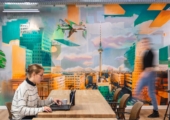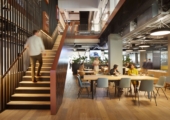Transform! Designing the Future of Energy,
Germany
23 March 2024
More information
2024 WELL Regional Summit: Mumbai,
Mumbai
18 April 2024
More information
Workplace Trends Spring Summit,
London and Online
18 April 2024
More information
Employment Law Update | April changes and what lies ahead,
Online
18 April 2024
More information
WORKTECH24 Basel,
Basel
19 April 2024
More information
Running Remote: Empowering The World's Transition Towards Distributed Work,
Lisbon
22 April 2024
More information
Ergonomics & Human Factors 2024,
Kenilworth, UK
22 April 2024
More information
The Office Event,
London
23 April 2024
More information
Featured
-

All change. Jennifer Bryan on the Workplace Cocktail Hour
-

AI may boost productivity, but we are already becoming reliant on it, and that’s a problem
-

From pixels to patterns: the unprecedented surge in screen time
-

CIFF Guangzhou 2024 proves a record-breaker and a major boost to international furniture trade
-

Don’t worry, be ‘appy. IN Magazine issue 20 is here for you
-

A day of learning for workplace designers
-

Older people less keen on early retirement than younger generations
© Workplace Insight 2024
Powered by WordPress • Themify WordPress Themes


















September 16, 2020
Get used to the idea of work as an experience rather than a place
by Tim Oldman • Comment, Flexible working, Property, Workplace design
Boardrooms are empty, but boards are still meeting and workplace is top of their agenda. This is an unbelievable opportunity to prove the value proposition of the workplace. But you can’t walk into a boardroom without data; you have to know how the organisation is performing now, how it was performing before, and how it might perform in the future with a new approach.
The world’s leading organisations are using this hiatus period to directly inform and evaluate the future workplace landscape. Collecting and aggregating data has never been so important. Highly empathetic organisations – those that place the employees at the heart of the experience they seek to curate – make it their business to understand what their people think, need and want because they understand the value of experience.
But the workplace machine, which can so easily strengthen or strangle experience, has a new competitor. And it’s working hard to offer employees an alternative to what they previously and unequivocally considered a central place of work. Offices and homes are currently battling head to head.
[perfectpullquote align=”right” bordertop=”false” cite=”” link=”” color=”” class=”” size=””]Activities critical to collective work processes, such as problem solving and idea sharing, are best supported in the office, whereas activities that require acoustic privacy are, frankly, better catered for at home[/perfectpullquote]
Read the tabloid headlines and you’ll be led to believe that the home is working just as well as, if not better than, the average corporate office. The data suggests that for many employees this is not the case. Since early March, Leesman has been benchmarking the remote working experience against the parallel office experience to conduct a gap analysis of where the office works best and where the home works best for the 100,000+ employees that we have surveyed. Activities critical to collective work processes, such as problem solving and idea sharing, are best supported in the office, whereas activities that require acoustic privacy are, frankly, better catered for at home.
Averages mask highs and lows. Workplace strategy must consider not only those in the immediate line of vision but also those struggling on the periphery. One in three employees do not have a dedicated space that they can use at home. These people are sofa-surfing, perched on the edge of a bed or teetering on the side of a kitchen table, and they report significantly lower satisfaction scores on every aspect of their experience.
Then there are the factors almost impossible to measure. Watercooler moments are a bit passé, but the fact remains that you can’t replicate chance encounters on a Zoom call. That, along with other factors, negatively impacts knowledge transfer, social interaction and creative collaboration.
There has never before been such a need to understand how employees are experiencing the environments in which they work. The world might feel like a different place now, but the one thing that has not changed is the role an employee plays in an organisation.
This first appeared in the new issue of IN Magazine
Main image: Evolution Design
Tim Oldman is the founder and CEO of Leesman which helps organisations understand and measure how well workplaces support the employees who use them.